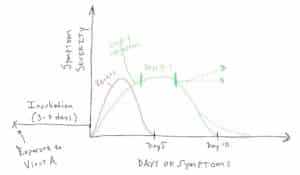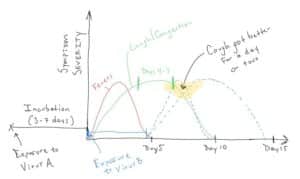
This time of year is exhausting for parents. In our last post, we mentioned how busy things were around Pediatric Associates and other clinics in the community. If you missed that, check it out here. That brings us to the first thing you need to know about respiratory viruses: THEY’RE HERE & THEY’RE REALLY, REALLY FRUSTRATING. That being said, let’s dive into the things that will help you navigate through this viral season.
- When does my child need to be seen?
- Trust your eyes more than your ears with the young ones. Little ones can make a lot of strange noises when they breathe because they don’t manage their congestion very well. Ever see your 14 month old “hock a loogie?” Us either. The younger they are, the worse they are at managing all that stuff in the upper airway (the space between the nose and the upper part of the “wind pipe”). Watch your child’s tummy and chest for “retractions.” These are signs that they’re working harder to breathe and we should check that out. In babies you can also watch the nostrils, which may be flaring with breathing if they’re working harder.
- What if it’s RSV?!

- Ah, the boogey man (no pun intended) of respiratory viral season. If you hear “RSV,” DON’T PANIC. It’s just another one of the viruses…the MANY viruses. In most cases, we don’t worry more about RSV than, well, enterovirus, human metapneumovirus, parainfluenza virus (1, 2, 3, or 4), rhinovirus, adenovirus…….It goes on and on. This kind of gets us back to: TRUST YOUR EYES. Most kids with RSV have a cold, and that’s it. Yes, it is known for moving down into the lungs, but you’ll know that by what you see.
- Cough, cough, cough, cough:
- The MOST ANNOYING symptom. Coughing is your body trying to keep mucus out of your lower respiratory tract. It’s a good thing…until the hours of 9pm-6am because that’s when we sleep, and that makes it really frustrating. It also happens to be when kids are flat and mucus tends to pool in the back of the throat where the cough is often triggered. If we could take one symptom away from you, this may just be the one. It also just happens that there is really not any good medicine for cough in young kids. If your child is older than 1 year, try dark, bitter honey. Studies have shown that it is just as effective as cough medicine without the potential side effects. Run a humidifier. Suction out the upper airway drainage from your baby’s nose/throat. Try and incline the mattress just a little bit (and from UNDER the mattress or at the crib legs for kids under 12 months), and HANG IN THERE.
- The type of cough can also help you and us figure out what may be the culprit.
- Wet, productive coughs are often just from all of the drainage.
- Dry coughs can be from asthma or other reasons for irritation of the lungs.
- Hoarse, barky coughs (“like a seal”) are concerning for croup and we’d recommend that you touch base with us to talk through things. Check this video out for a good example of cough types. No, this is not an endorsement of this show or information that is communicated on it, but we can get behind this video.
 Just give me antibiotics, please!
Just give me antibiotics, please!
- Remember, antibiotics don’t do anything for viruses. In the wise words of a former pediatrician in the practice, “I can give you antibiotics for this virus and your child will be better in 7 days, or we can let her immune system fight it off and she’ll be better in 7 days.” Yes, it’s easier for us just to give the antibiotics too, but that doesn’t mean they’re doing anything….other than creating more resistance out there and giving your kid diarrhea…..and a rash….and who knows, maybe anaphylaxis.
- There may be some scenarios where they are important. Unfortunately, most of them require a good physical exam so that we know which antibiotic to choose, how long to treat, and what to tell you to be watching out for.
- Let’s go to virus school and look at a couple of figures to give you some insight on what’s going on in our minds when we’re working through a patient with a viral respiratory illness. Hopefully this will help you to anticipate what your child may go through.
 FIGURE 1:
FIGURE 1:
The life cycle of Virus A. Notice that “X” marks the time of exposure. Thanks a lot “other kid” in daycare who coughed in my kid’s face. The incubation phase (time when a patient has NO symptoms) for most of these viruses is about a week. Some important facts:
-
-
- Fevers are typically gone by day 5.
- Cough and congestion can last up to 10-14 days and ARE THE WORST AROUND DAYS 4-7.
- Children who have fever longer than 5 days or cough congestion without improvement for more than 10 or so days (dotted green line with arrows) probably need to be evaluated.
- If your child is on day 6 of cough and congestion and fevers have gone away, HANG IN THERE.
-

FIGURE 2:
Here’s where things get really annoying. At any time when you child is fighting Virus A, that “other other kid” from daycare can cough in her face again. And so starts the course all over again (Virus B, in blue), making it seem like symptoms last FOR – E – VER.
-
-
- But note the highlighted area. This shows a day or two of improvement in the symptoms…a tale tale sign that you’re likely dealing with a new virus. It’s a bummer. We know.
- The average number of viral respiratory infections a child will get during viral season is FIVE TO SEVEN!! That’s a lot of days of symptoms….and less sleep.
-
So, that’s a LOT of information. Let it settle. Use this as a resource over the next few months. You can find this blog post on our website easily. And ALWAYS call if you have questions. The goal of this post, though, is to provide you with some of the answers and help you anticipate some of the decisions we’re making.
Our greatest privilege is caring for your children,
Pediatric Associates